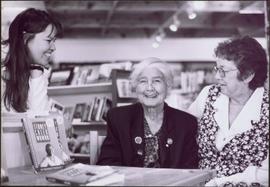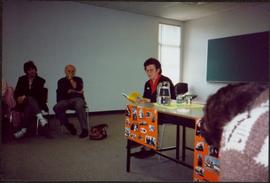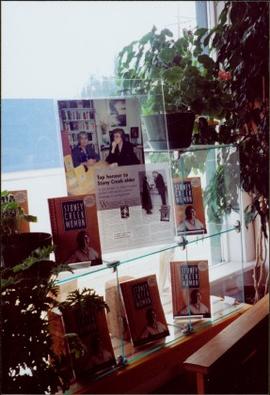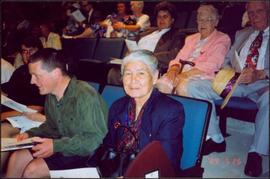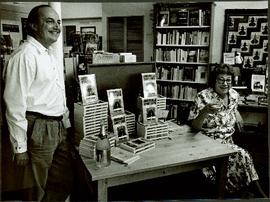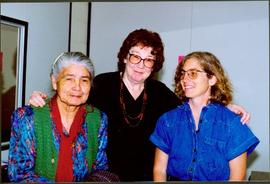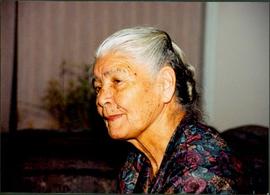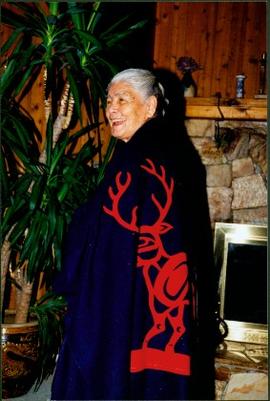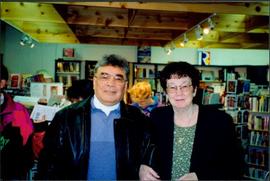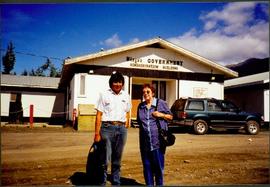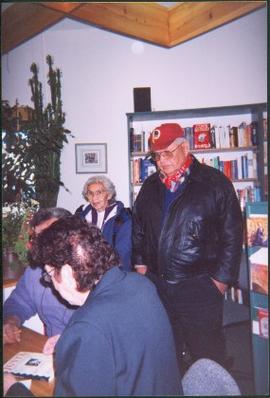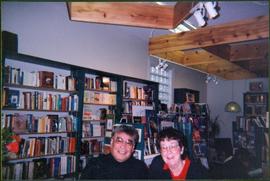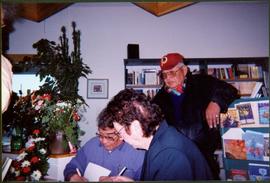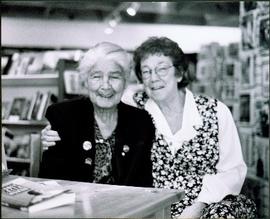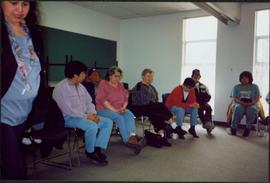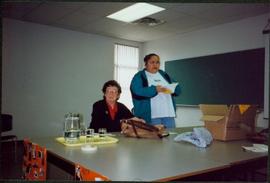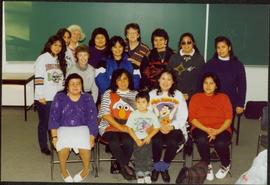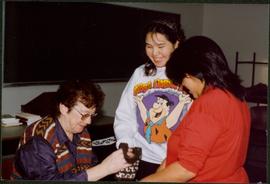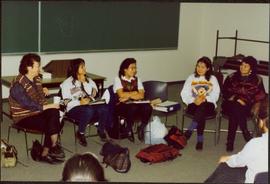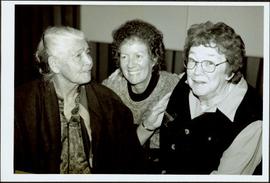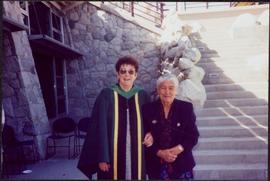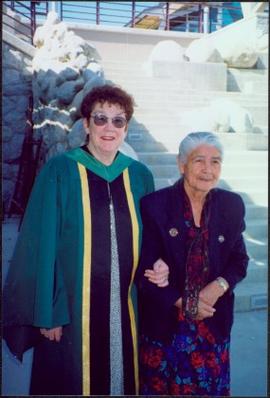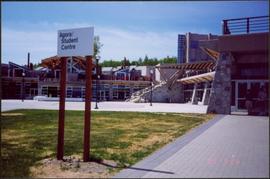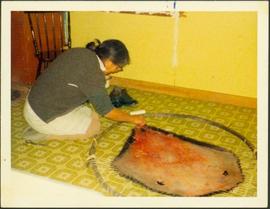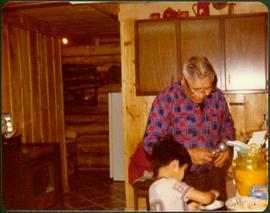Photograph depicts Moran seated to right of Mary John at table displaying copies of 'Stoney Creek Woman'. Unidentified woman stands on left, bookshelves can be seen in background.
Photograph depicts Moran reading excerpt from her book while seated beside table in classroom. Unidentified man and woman can be seen sitting in chairs against wall in background.
File consists of one draft and one original copy of a full page advertisement featuring four books written by Bridget Moran: Stoney Creek Woman, Judgement at Stoney Creek, A Little Rebellion, and Justa: A First Nations Leader.
Photograph depicts numerous copies of 'Stoney Creek Woman' (by Bridget Moran) in glass case. Display also features article on Mary John's receipt of the Order of Canada (see items 2008.3.1.22.61 and 2008.3.1.22.64 for photographs displayed in this image).
Item is a audio interview recorded by Bridget Moran with Jimmy, Rosie, Nancy, and Madeline.
Audiocassette Summary
00’ 05” Continuation of interview with Jimmy. Jimmy says his grandfather is French, not German, like Justa thinks. Moran and Jimmy continue to talk about the history of his grandparents. Jimmy continues to talk about his family history. They talk about the history of their last name, Monk.
12’ 08” Interview changes to Rosie. Moran asks Rosie about her siblings and other family history. Moran asks about the history of their last name, Monk. She believes her descendants are French. They continue to talk about her family history.
19: 22” Moran asks Rosie about the time Justa murdered John. Rosie talks about the situation candidly. She talks about John’s family life.
26’ 30” Moran asks Rosie about attending residential school. Rosie says school was alright for her, that they looked after them. She came home after six years.
28’ 30” Rosie talks about traveling around with her father because he worked many different jobs.
29’ 55” Rosie talks about getting married, how she got to choose her own partner, instead of having it arranged. She discusses her children.
32’ 05” Moran asks if Rosie had a good childhood. Rosie says yes, but her parents were strict. She remembers her father having to pay a land tax because they did not live on reserve land. She continues to talk about her childhood.
37’ 16” Rosie talks about life in residential school. Nancy says the nuns were kind; that they had to punish them if they spoke their native language.
38’ 50” Interview changes to Nancy. Moran asks about the history of their last name, Monk. They talk about her family history.
45’ 43” Moran asks Nancy about the time Justa killed his brother, John. Nancy talks about what she can remember.
47’ 32” Moran asks Nancy about the death of her brother, Teddy. She tells Moran the story she was told by the police.
49’ 34” Moran asks Nancy when she went to residential school. Nancy talks about having convulsions, so only spent two years there, then came home. When she was feeling better, she went back for another two years. She said her time there was not that bad, but she was homesick and lonely.
53’ 16” Moran asks Nancy if she had a good childhood. Nancy tells her she did, that they did everything for their parents.
56’ 07” Interview changes to Madeline. Moran asks about the history of their last name, Monk. Madeline does not know much about it. They continue to talk about the history of the family.
1:02’ 45” Madeline tells Moran about how she knocked Justa out with a block of ice because he was teasing her when they were children. Justa was a big tease, she says. Madeline says that Justa collected a box full of ‘treasure.’
1:09’ 10” Moran asks Madeline about her mother and how much she sewed for other people.
1: 10’ 44” Moran asks about when Madeline went to residential school. She tells Moran that she liked it there. Those who went there have discipline, she says.
1: 12’ 55” Madeline tells Moran that her parents were strict. She talks about being punished when breaking the rules, much like being at the residential school. They return to discussing residential school.
1: 17’ 55” Moran asks Madeline about what she remembers about the trips between Portage and Fort St. James. She talks about traveling by canoe once with her grandfather.
1: 20’ 33” Moran tells Madeline what she plans to write about in the book, particularly the first chapter dealing with the family history and life before the road being built to Portage.
1: 23’ 25” They return to talking about the family history, including aunts. They talk about her siblings.
1:30’ 07” Moran asks about Justa Hanson, the man Justa was named after. He was living in Tachie at the time Justa was born.
1:32’ 40” End of tape.
Item is a audio interview recorded by Bridget Moran with Justa Monk.
Audiocassette Summary
00’ 10” Moran asks Justa about living ‘three lives.’ Justa discusses the three phases of his life – childhood, getting in trouble, and being in a leadership role.
03’ 10” Moran asks Justa to discuss his older brother John. Justa talks about John and his personality and his relationships.
07’ 35” Justa discusses the trouble he got into with John. Justa does not remember what started the fight, because no one wanted to tell him what had happened. Justa does not remember killing his brother, but discusses how he wanted to commit suicide after finding out the truth. Justa also talks about his jail time.
24’ 14” Justa talks about his move to Dawson Creek to do upgrading. He still had the intention of Justa talks about adopting his niece.
26’ 03” They return to discussing Justa’s committing suicide. He felt guilty about taking his brother’s life. They also discuss his alcoholism.
35’ 25” Moran asks Justa about how he felt about being Indian or being treated as a second-class citizen. Justa says he is proud to be Indian.
38’ 35” Justa talks about being slapped as punishment for using his native language at school. He talks about kissing a girl and getting caught. He talks about his other punishments at residential school, and how he got tired of a specific teacher. He continues to discuss the school and assimilation into the ‘white world.’
53’ 35” Moran asks about the name he was named after, Justa Hansen, who was from Tachie. Justa talks about how Hansen was an important leader of the community.
55’ 52” Moran asks about ‘Indian’ food, such as deer, bear meat and salmon. He loves this type of food dried.
58’ 49” Moran asks Justa when he became tribal chief. He talks about the history of the position and how he became the tribal chief.
1: 03’ 30” Moran asks about Justa’s father’s potlatch. He talks about his parents’ death.
1: 07’ 17” End of tape.
Item is a audio interview recorded by Bridget Moran with Justa Monk.
Audiocassette Summary
00’ 10” Moran asks Justa to identify reserves on a map. Moran tells Justa she wants to start the book with the history of reserves Justa lived in or around. Justa was born in Fort St. James. Moran asks what he wants to name the book.
05’ 10” Justa talks about how long it took to get from place to place when he was a child. He talks about what types of transportation was used in the different seasons. He also discusses how the way of life changed when the road was built between Fort St. James and the other reserves. Moran suggests the road was bittersweet because of the loss of community.
25’ 30” Justa is concerned about the loss of Indian culture to younger generations, so speaks his language often. He also worries about the dependency First Nations have on modern conveniences, so have forgotten how to live off the land.
33’ 56” Moran asks how Justa feels about ‘culture camps.’
38’ 25” Moran asks Justa which clans are in Tachie, where he names several.
40’ 05” Moran tells Justa she has been reading his diaries and how she feels he is being killed by meetings once he became band manager. Justa says the meetings are beneficial to teaching himself what he needs to know.
42’ 35” Justa talks about his nervous breakdown because of the amount of meetings he had to attend, which he averages at about one thousand a year.
43’ 36” Moran asks Justa what the central concerns were for Tachie. Justa tells her hydro, sewage, telephone and cable services, and schools. Justa talks about the schools, in particular.
49’ 46” Justa talks about the new band manager of Tachie.
50’ 09” Moran asks about the Kemano Project. Justa tells her there are lot of uncertainties, but he is not sure what they are at the moment. Justa thinks the government will go ahead with Kemano II regardless of what the public think.
57’ 27” Justa talks to Moran about the qualities of being a leader. His father told him he was too radical to be leader and had to respect other people’s opinions and nationalities to be successful. People are more supportive of his ideas now.
1: 00’ 50” End of tape.
Item is a audio interview recorded by Bridget Moran with Justa Monk.
Audiocassette Summary
00’ 10” Moran asks Theresa about when she first started living with Justa. They discuss the beginning of their relationship. Theresa discusses her former husband, how she began drinking because of his abuse. She says Justa made her settle down.
11’ 22” Moran asks Theresa about the things her and Justa do together. She says they garden. She says he looks after her well, but in the past Justa ‘slapped her around’ when they were drinking. Theresa talks about her past with alcoholism and how it affected her relationship with Justa.
18’ 30” Moran asks about when Justa and Theresa got married. Theresa talks about the wedding. Theresa talks about how Justa’s parents initially did not accept her, but they eventually started to treat her well when they saw Justa and her were doing well.
21’ 35” Moran asks Theresa about her children. Theresa discusses them all individually. Two of her daughters were killed.
31’ 45” Moran asks Theresa about going to Tachie for salmon fishing. Theresa talks about the process of fishing from the shore. Theresa also talks about hunting and preparing for the winter.
37’ 45” Moran tells Theresa no names will be mentioned in the book, such as the last name of her first husband.
37’ 59” Moran asks Theresa why she thinks alcoholism is such a problem on the reserves nowadays.
42’ 59” End of tape.
Item is a audio interview recorded by Bridget Moran with Justa Monk.
Audiocassette Summary
00’ 06” Justa is talking about the Kemano II Project and what he said in a meeting with the Ministers. He has asked them to stop the Project or they will face judicial review because they are basing the Project on a political basis, not a scientific basis. He says he feels he will win the case.
04’ 57” Moran tells Justa she is working on the chapter about when he kills his brother John. Moran asks Justa about what happened and he tells her all he remembers is when the cops arrested him. They continue to talk about what happened, though Justa’s memory is vague. Justa talks about his time in prison.
24’ 54” Moran asks Justa about when he moved to Fort St. James after he was released from prison. He moved to Dawson Creek after being picked arrested again.
27’ 58” Justa talks about moving back to Tachie, then going to work for BC Rail in 1970. At that time, he was hired as band manager.
28’ 50” They return to discussing the Kemano II Project.
32’ 20” Moran and Justa return to discussing the murder of his brother.
34’ 50” Moran and Justa talk about Brother Anderson, who worked at the residential school.
41’ 15” Moran talks to Justa about his brother Alec who passed away at a young age. The person who fell off a roof was a cousin.
42’ 30” Moran asks Justa about being left on Haldi Road when he was working at the rehabilitation camp. He talks about Haldi Camp and it was decent living conditions. There was no counselling offered.
47’ 57” Moran asks Justa if his troubles at that time were related to alcohol. He tells her that his fights were caused from drinking. He talks about his parents telling him they were worried about his drinking. He began to black out, but did not worry about it because he says he was young and did not pay attention.
49’ 55” After Justa left Dawson Creek, he returned to Tachie. Two weeks after he was home, Teddy was shot. They talk about the circumstances surrounding his death.
56’ 08” Moran asks Justa about his memories of Tachie when he started as a maintenance man in the 1970s. He says the roads were rough or hardly there. He talks about his job shovelling snow or pulling vehicles out of the mud. They talk about the Tachie community in the early 1970s. Justa talks about building the community up.
1: 08’00” Justa talks about his wedding to Theresa. Very few people attended the wedding. It took a long time for Justa’s family to recognize her as part of the family.
1: 12’ 54” Moran asks Justa about life in Tachie. Justa tells her things were done collectively, there was no division within in the community. He wishes the old way of life was still a part of the community. He talks about the love of ‘potlatch’ in the community. He talks about how the old way of life disappeared once the road was built.
1: 19’ 50” Moran asks Justa what he is working on. Justa says he is wrapping up the treaty process, budget proposals, and a couple other issues. He talks about Kemano II. He is serious about leaving his position because he has been neglecting his family. They continue to talk about the Kemano II Project.
1: 29’ 09” End of tape.
Item is a audio interview recorded by Bridget Moran with Justa Monk.
Audiocassette Summary
00’02” Justa is talking about the store in Tachie.
02’ 13” Moran asks Justa to clarify his different positions when working for the band, and when he served in those positions. He talks about the years he was band manager and tribal chief, and talks about these positions. He discusses the stress of the positions because of lack of funding.
16’ 29” Moran asks Justa about the different programs, such as water systems and education. Justa discusses getting the water system into Tachie. He discusses the details of trying to get the water system, particularly trying to get funding and getting the proper contractors. He talks about the stress of the position and how it affected his mind.
39’ 04” Justa talks about the differences between being a band manager and a tribal chief. He tells her there were no politics involved in being a band manager.
41’ 30” Moran asks Justa to draw her a map of Tachie and Sunnyside for the book, so she knows where everything can be found. Justa draws her a detailed map that includes the lake and the river.
52’ 34” Moran asks Justa about his week as a band manager and tribal chief, starting from Monday to Friday. He talks about his meetings involving contracts, social assistance, education, and other funding concerns. He reads from his diary to Moran.
1:02’ 55” Moran asks Justa about when Tachie received a telephone system. Justa talks about how he actually regrets getting a telephone and television system because of the loss of community.
1:08’ 55” Justa returns to talking about Kemano II.
1:14’ 59” Moran’s voice is muffled and incomprehensible.
1:16’ 35” Moran asks Justa for photographs for the book. Moran wants a subtitle for the book, so asks Justa for something in Carrier. Moran tells Justa that the CBC has asked why she is writing a book about him. They discuss the general details of the book.
1:26’ 17” End of tape.
Audio recording consists of an interview conducted by Bridget Moran with Mary John.
Audiocassette Summary
Scope and Content: Recording starts referring to this as a continuation of previous discussion. Mary John talks about fishing and refers to tools in Carrier language.
0’01” She talks about having her children and the use of midwives – and laying of hands by the mid- wives as a healing ritual. There were no doctors in area where Mary had all her children. Recalls in 1946 going to Vanderhoof to see a doctor for one of the more difficult births. Talks about use of mid-wives at Pinchi Lake mines when they [her husband and her worked at] cutting wood for the mines there
8’00” Mary John recalls coming to Fort George – living in tent camp near the tracks. Her Husband worked for a man named Koop
9’00” Mary talks about her children going to Lejac, the Indian residential school “they were lonely and we were lonely….there was silence….everyone [kids] were gone” She recalls that the dids didn’t come home for Christmas – left in September and came back in June. Talks about transport of the kids “big truck” came to get them in the fall to bring them to Lejac.
Mary discusses her own school life at Lejac in 1922 at age 7 – recalls her initial thoughts about going to school; being delivered to the school; remembers talking to her parents once on the telephone from Lejac and being very homesick. Describes where the “Mission School” was located; recalls there were about 40 kids there. Talks about the teachers who were nuns and recalls various students at Lejac; notes she was there until 1927. She left school and a Mountie was sent after her to bring her to Lejac but her mother needed her to stay to look after the other children
20’00” Recalls an “Indian doctor” who came to town from “down south” who was not trusted by the local people who was ‘taking sickness’ out of people and ‘charging for it’ – caused a scandal – “singing hymns” heard he was from the Kootenays. [religious zealot?] they were afraid the Missionaries would punish the children for going to him.
21’00” Mary talks about being punished at Lejac – recalls running outside doors before whistle blew, and the sisters would whip them with a dry willow; says she wasn’t strapped but recalls seeing many strapped
22’00” Mary notes that spoke Carrier as first language and then in Fort St. James took a year to learn a little bit of English. She wasn’t aloud to speak her language at Lejac – she now feels ‘quite bitter’ about that and especially now most parents don’t speak Carrier or teach it to their children at home now
27’00” Mary notes there was no option to send her own kids to public school in Vanderhoof as they had to go to residential school
29’00” Mary John recalls one nice Scottish woman who she worked for in Vanderhoof c.1927
32’00” Mary John talks about where her kids went to school. She continues to talks about where native kids now go to school including at the Price George College
33’00” Mary John discusses her educational experiences at Lejac –
34’00” She recalls that the quality of the food at Lejac– it wasn’t good; too much porridge; not much meat; her job was to clean the dishes of the nun’s dinner tables so she would eat the remainder off their plates. Remembers occasionally getting fish smoked from a community resident and enjoying this
36’00” Discusses the church services at Lejac; singing lessons
38’00” Discusses outings from the school on the weekends including Robinson Point
41’00” Talks about picking roots as her job; recalls that the boys and girls were separated at the school; noted you would be spanked if you talked to a boy at the school; sexual interest shown between the girls and boys
44’00” Bridget asks about the girls experiences with menstruation – Bridget recalls a conversation ‘years ago’ when Bridget brought out a girl from India and that girls in India had to be separated when menstruating; Mary John notes that native girls also had to be isolated; it was considered an unclean time. It was the native belief that if a girl/woman had handled the meat/food for preparation during menstruating, it was considered bad luck for the hunters so the girls/woman were isolated from the community during that time of month.
51’00” Mary John herself did not believe in this custom. So there was a sense of relief when menopause came
End of that session Then tape starts again
51’05” Bridget notes it must have been difficult to talk to boys after boy-girl separation at Lejac; notes she was too shy to talk to boys
54’00” Bridget asks her to talk about her (Mary John’s) ancestors
Her Mother was Angele Quaw; her grandmother was known as ‘Six Mile Mary’
58’00” Bridget refers to a tape that she did many years ago with Granny Seymour and that Mary John may be able to make out some of the recording; Mary John notes that her mother was born in 1900; had Mary when she was only 13 with older man
61’00” Mary John talks about her biological father; had difficult relationship with him; he didn’t want a relationship as father-daughter
64’00” Mary talks about her mother’s marriage to Johnnie Paul at age 17; and they moved to Stoney Creek; they had 6 children; her mother died in 1934 in child birth.
68’00” Mary’s mother’s husband had died a month before she did; Johnnie Paul and James Antoine died at the same time from drinking bad home brew
71’00” Talks about taking care of her siblings after her mother’s death from childbirth
72’00” Talks about Johnnie Paul being a trapper and having a trap line at Stoney Creek
74’00” They discuss Mary John’s mother and grandmother genealogy; Quaw family of Fort George
78’00” Bridget asks her what her early memories would have been of Stoney Creek; Mary recalls tending to her mother during the flu epidemic. Recalls people being buried in blankets; too many people and no time to build coffins. Recalls Father Cocola and Lejac again.
84’00” Mary recalls going to their family hunting grounds at Cluculz Lake in September to hunt; use tents to stay in while hunting; stayed there about a month to hunt/snare animals. Recalls having a shack at Wedgewood in the winter where her step-father worked for the logging contractor.
89’00” begins to talk about memories of Wedgewood
End of tape
Audio recording consists of an interview conducted by Bridget Moran with Mary John.
Audiocassette Summary
Context: Recording is the continuation of earlier sessions by Bridget and Mary John talking about her life – appears to continue on from the other tape sessions numbered to #8 [Accession # 2008.3.1.211.4]
Side 1: “Mary John #9”
0’05” Bridget interviews Mary John and asks about Mary John’s grandmother who lived at the reserve at Fort George. Mary notes that her grandmother was sent back to Fort George and then to Stoney Creek after husband died. Her Grandmother remarried; she died in the 1950s. Mary talks about her grandmother’s marriage with Za (Jean) Paul – that was not an arranged marriage; her Grandmother “she had a hard life”
4’00” – 7’30” Mary Johns’ mother married Johnny Paul – not arranged; Mary notes that she was born in Fort George. Mary lived with her Grandmother Ann on reserve in Fort George. Mary then talks about her sister Bella – who married Mike Ketlo (sp?) and their children. She died of tuberculosis in the 1950s.
7’40” Bridget asks about the Mission School in Fort St. James – near the church “that is on Mission land” Which is where the village originally started. They talk about the church’s history briefly.
9’00”-14’00” Bridget asks Mary about her schooling at Lejac – Mary says they had reading, writing, arithmetic, penmanship and history. There was no science taught. Mary then describes the routine at Lejac. Doing chores and then breakfast at about 7:30 and then did cleaning chores in the dormitories. Then they attended their classes; then lunch, then played outside and then came back for sewing or embroidery, knitting and then back in classes until 4:00pm. Mary describes recreation – swimming, playing in the field, chores – pulling roots/stumps etc. Bridget talks about Joanne (Fiske?) thesis on the distinction between native boys and native girls’ activities and education at the residential school and that it enabled them to go to work in the hospitals and offices but that the farming education that was taught to the boys didn’t help them as there was no agriculture on the reserves. Mary notes she was ‘teachers pet’ as she had music lessons for singing. Mary notes she didn’t do anything in the kitchen but took mail to the post office and looking after the office for the Mother Superior. She feels she learned ‘the basics’ [but] then they ‘kicked you out at 16’
15’00” Bridget asks about the differences in disciplining methods of children – she notes that it is not part of Indian culture to spank children. She notes it is part of her husband’s sisters to discipline her children – not her or her husband’s duty
17’00” Mary talks about the residents at Stoney Creek who objected to school at Lejac because of harsh disciplinary methods used with their children
18’00” Mary talks briefly about the food at Lejac and speaks briefly to another unidentified woman [Sabrina?] in the room about food preparation [canning?]
19’50” Bridget asks about the Stoney Creek residents who wanted to have a school at the village in the 1950s and wanted their children to go to school there.
20’00” Mary speaks briefly about Father Coccola and that he did the negotiation about the move of the people from the reserve at Fort George to Shelley and about some compensation acquired by the residents. Bridget notes he ‘did not do a favour to the Indians’ – Mary notes that they were forced to leave ‘very illegal’
22’00” Mary speaks again about Father Coccola who could be ‘a very strict man’ but who took care of the people when they were sick and dying
23’00” Mary talks about another priest (unidentified) that she really liked who gave her a job c.1935 when she and her husband cleared land for Lejac and the priest treated them really well. She thinks he was from the Yukon as he had gold nuggets
25’00” Mary talks about her children going to Lejac in the 1950’s
26’00” Bridget talks about a social worker who came to Stoney Creek in c.1955 and Bridget was asked to come out by the Indian Agent to investigate what was the issue. This social worker was scared of being on the reserve; Mary thinks this woman had marital problems and drank a lot
28’00” Mary talks about the Day school operating c.1951 for a short time and the kids were bussed back and forth; other kids ‘orphans’ went to Lejac (lived there)
Tape is poor after this; noise with squeals and recording is faster
29’00” Mary talks about her children (Helen and the boys) not liking Lejac. She notes that one of the boys didn’t like it ‘but didn’t complain’ about it. She notes that ‘no one would talk about it’ “the whole village would be silent” when they left; and the children would be crying.
30’00”-33’00” Bridget asks Mary to discuss her wedding in more detail – Bridget notes that she already has on tape about the wedding night itself but asks for more information about the wedding day. Mary begins to talk about the wedding; there was a Mass, the guests and there was a band….
Tape is unintelligible after this; recording is broken up with interference and then there is no recording End of side 1
Side 2 “Mary John #10”
This side of the cassette has no recording
Audio recording consists of an interview conducted by Bridget Moran with Mary John.
Audiocassette Summary
00’05” Bridget is interviewing Mary John who discusses a potlatch held at Stoney Creek that Bridget attended. Bridget asks about the talking stick and she asks Mary John to explain its significance. Mary explains there had been a naming ceremony about a year ago and that a woman named Maisie had changed clans from her mother to her father’s clan. Mary notes while this is unusual, her father’s only son had died and therefore requested that the daughter changed clans. At this ‘September potlatch’ therefore this woman had to change tables at the potlatch.
04’00” Mary explains the context of the September Potlatch. She notes that Maisie had hosted this potlatch to pay back for the gifts that had been provided for her from a year ago when she received a new name. They then discuss the amount of money that the host gave to the guests and the amount of money that is normally provided – there is no particular amount ‘whatever you wish’ Mary notes she had provided Maisie with a gift last year of $100 but that Maisie gave her back $200 – that is not required – there is no required amount
07’30” Mary explains that at a potlatch you are expected to bring a case or few bags of food
08’00” Mary discusses the type of food provided at a potlatch; it is traditional food not western food; Bridget notes there was caribou provided there. Mary explains that the host of a potlatch asks people to hunt for moose and deer meat in order to prepare for the food to be served. Bridget then talks about the food that was served and Mary notes it included also fish and beaver.
11’00” Bridget asks Mary to talk about the gifts given to her daughter Flo at the potlatch in exchange for a loan she provided to another woman whose husband had died a year before. Bridget notes it was a ‘touching’ moment.
12’00” Mary talks about the Priest ‘Father Brian’ who was at the potlatch. Four clans collected money and gave it to the priest for his work [missionary work?]
15’07” Mary explains the situation of Geraldine Thomas –that at the potlatch she was not seated before; that is she was not initiated before and so she was seated at the potlatch
15’57” Tape stops momentarily
16’09” Mary continues to talk about Geraldine and the potlatch events; the significance of the tapping of the talking stick; then she was seated and guests give her gifts. Then Mary talks about Ernie and her late daughter Helen who also wanted to cross their clan but that Mary ‘did not let her go’
20’00” Mary talks about the feelings of a child who gives up their clan and that it is like ‘giving up one of your children’ as Celina noted to Bridget at the event.
21’00” Mary talks about her son Ernie who crossed over to his father’s clan and that he was gifted at the potlatch
22’00” Bridget then notes that at this potlatch that the Frog Clan became host of the Grouse clan at this potlatch. Mary explains that the clan then had debts to pay at this potlatch.
26’00” Mary talks about the death of Stoney Creek members; she is unsure when there will be another potlatch in Stoney Creek.
28’00” Bridget notes that she did not understand the ceremony as it was in Carrier language; however Bridget notes it is a pity the white world doesn’t see potlatches as they are ‘so touching’
31’00” Mary explains that each clan takes care of the deceased family members and takes care of putting up the headstone
32’00” Tape ends abruptly
Photograph depicts Mary John sitting next to aisle in Canfor Theatre at the University of Northern British Columbia in Prince George, B.C. Unidentified individuals seated in foreground and background. Accompanying note from Maureen Faulkner: "Mary John takes my seat." Photo taken on the day Bridget received an Honourary Law Degree, before ceremony began.
File consists of Misc. typewritten notes under the following titles: the name "Nulki Lake," indian medicine, alcohol on reserve, housing on reserve, T.B. on reserve, indian agent, the Watchmen, the Church, alcohol, and families on Stoney Creek; typewritten notes under the following titles: early life, ancestors, Mary's childhood (racism), Mary's childhood (menstruation), Mary's childhood (the 1918 Flu), Mary's childhood (on the trapline), Mary's childhood (the trapline), Mary's childhood (her first coat), Mary's childhood (Christmas), and Mary's childhood (camping out and going to a Potlach); typewritten notes under the following titles: Mary's school days, childbirth, school life of Mary's kids, Mary's marriage, Lazarre's mother, marriage - housing, marriage - children, marriage - shopping in town, marriage - finances, marriage - work, work - depression, Indian Agent, marriage - hard work, camping, Lazarre's cabin at Wedgewood, doing hides, social life, whites, survival, Lazarre's family, Indian Agent and department of Indian Affairs, politics on reserve, citizen of the year, Catholic school, hides, potlach, siblings, net fishing, and changes; Lejac School: Thesis "And Then We Prayed" (pages 1 - 9) and questions for Mary.
Photograph depicts Bridget Moran seated at table covered with copies of her book. Unidentified man stands on left, bookshelves visible in background.
Photograph depicts Bridget Moran standing between Mary John (on left) and unidentified woman. Accompanying photo caption: "Caribou College, Quesnel, March /92".
Close view of Mary John. Plant, couch, and window in background.
Photograph depicts Mary John wearing long blue material with red caribou in traditional artwork on back. Plant and ornamented fireplace in background. Photo speculated to have been taken in Mary John's home.
Justa Monk and Bridget Moran stand in foreground. Unidentified individuals can be seen in bookstore in background. Bridget Moran published a book in 1994 entitled 'Justa: A First Nations Leader, Dakelhne Butsowhudilhzulh'un'.
Photograph depicts Bridget Moran standing beside unidentified man in front of white building with the sign "Nisga'a Government Administration building". Suburban parked in front of building, trees and mountains visible in background.
Photograph depicts Justa Monk and Bridget Moran seated at table, signing copies of 'Justa: a First Nations Leader'. Plants, bookshelves, and two unidentified individuals in background.
Photograph depicts Justa Monk and Bridget Moran seated in bookstore, bookshelves in background.
Photograph depicts Justa Monk and Bridget Moran seated at table, signing copies of 'Justa: a First Nations Leader'. Plants, bookshelves, and unidentified man visible in background.
Photograph depicts Moran with arm around Mary John, both seated at book display table. Bookshelves in background.
File consists of newspapers (all dated 1976) include: The Citizen; and The Nechako Chronicle featuring articles on the Thomas inquest. File includes the Nechako Chronicle, vol.60, no.26, Thursday July 1, 1976.
File consists of "My notes as free lance reporter at Press Table during the inquest into Coreen's death. September 24-27, 1976." [68 handwritten pages].
File consists of:
- Newspapers include: The Georgia Straight, The Province; The Indian Voice; The Toronto Globe; The Vancouver Sun Weekend Magazine; The Vancouver Sun; The Citizen; and The Nechako Chronicle each featuring articles on the Thomas inquest.
- Report of inquiry as to cause of death of Faye Helen Huagen, Vanderhoof, B.C., December 27th, 1979.
- Copy of Canadian Welfare #5, Sept/Oct. 1974 issue.
- Copy of B.C. Police Commission report to Vanderhoof Mayor W.L. McLeod, November 1, 1976.
- Copy of letter from Helen Jones, Secretary of Stony Creek Indian Homemakers Club to the Honourable Garde Gardom, Attorney General of the Province of British Columbia regarding Richard Redekop (November 19, 1976).
- Draft version (includes annotations) of "Introduction" to Judgement at Stoney Creek sent to Bridget Moran from Mayo Moran, (Feb. 1990).
- Handwritten draft of a letter written to Vanderhoof Mayor Bill McLeod
- Copy of handwritten letter from Helen Jones [Secretary of Stony Creek Indian Homemakers Club] to Bridget Moran (?), November 22, 1976.
File consists of a Teacher's Guide for Justa.
File consists of an annotated transcript of interviews between Bridget Moran and Justa Monk.
File consists of:
- "Past mistakes recorded in new book" (Vancouver Sun, May 8, 1995)
- "Murder led to election as tribal leader: social worker recorded story" (Vancouver Courier, Dec. 28, 1984)
- Transcript of "Harkins! Bob Harkins Comment" re: Justa publication (Monarch Broadcasting, Nov. 21, 1994)
- "Fascinating life, times of Justa Monk" (The Prince George Citizen, Feb. 2, 1995)
- "Justa: A Review" (Central Interior NDP News)
- "Blanket coverage" (B.C. Bookworld, spring 1995)
- "Manslaughter, then Justa for all" and "Blanket coverage" (B.C. Bookworld, spring 1995)
- Fax from Laura Boyd, Northwood Pulp & Timber to Justa Monk (and Bridget Moran?) re: names and positions of executive staff at Northwood (Nov. 14, 1994).
Photograph depicts group of unidentified men and women seated in chairs in unknown classroom.
Photograph depicts Bridget Moran seated beside unidentified woman who stands reading excerpt from Moran's book. Table with miscellaneous items in foreground, window and chalkboard in background. (Standing woman also featured in item 2008.3.1.102.5).
Photograph depicts a young boy and group of fourteen women posed for photograph in classroom, chalkboard in background. Handwritten annotation on recto of photograph: "Aboriginal Women's Training Program, Cowichan Campus, Malaspina University College, Duncan BC".
Photograph depicts Moran seated to left of two students presenting small knitted craft. Desk and chalkboard in background. Photograph was taken at session of Aboriginal Women's Training Program at the Cowichan Campus, Malaspina University College, in Duncan B.C. Handwritten annotation on recto of photograph: "Gifts from Charlene + Joanne Smith".
Photograph depicts Moran seated on far left, in circle of women in classroom. Desk and chalkboard in background. Photograph was taken at session of Aboriginal Women's Training Program at the Cowichan Campus, Malaspina University College, in Duncan B.C.
Close view of three women at unidentified location. Left to right: John, Hope, Moran.
Item is a audio interview recorded by Bridget Moran with Justa Monk.
Audiocassette Summary
00’ 01” Justa is talking about the Kemano II Project, which he states is a political issue, not an environmental one. He says the Project is a public issue now, not just a First Nations issue.
06’ 52” Moran asks Justa about when he was elected to tribal chief. He talks about the nominations process.
09’ 52” End of tape.
Item is a audio interview recorded by Bridget Moran with Justa Monk.
Audiocassette Summary
00’ 04” Moran is talking about book signings for Justa’s book.
00’ 27” Justa and Moran talk about board members for the Kemano II Project. They continue to talk about the Kemano II Project. Justa says the amount of pressure he is putting on the government, combined with public support, hopefully means Kemano II will be stopped. They continue to discuss the details and the politics surrounding the Project.
10’ 26” Moran asks Justa whether he was surprised or not when he lost the position of tribal chief at the last Assembly. He tells her he was not surprised. He talks about the first time he resigned from the position due to stress. He says the band knew he was tired, so did not want the position any longer. In a letter he wrote, he stated it was time for some new blood.
21’ 11” Moran asks Justa about his new position. He talks about being a contractor to Northwood Pulp and Timber where he liaisons between First Nations people and the company on employment concerns and tree sales. He talks about his position in more detail.
28’ 46” Moran asks Justa about how he feels about his life now. He tells her he feels good about what he has accomplished, but he needs a rest. He talks about his accomplishments throughout his career. He tells Moran he has no regrets about anything.
37’ 55” Moran asks Justa about his health issues and how he is feeling now.
38’ 57” End of tape.
Item is a audio interview recorded by Bridget Moran with Justa Monk.
Audiocassette Summary
00’ 10” Moran is asking Justa about how he is feeling because he had a major heart attack. He talks about recovering from his attack in a week.
02’ 15” Moran asks Justa about what he thinks about the Gustafson Lake situation. He says he predicted it because the government has not been serious enough in negotiations for land claims. He does not believe in militant reactions and wants peaceful negotiations.
04’ 54” Moran asks Justa about what helped him get out of the ‘trench’ he was in after murdering his brother. He was able to carry on partly because he was forgiven by his family and the elders. He says the elders were the people who convinced him to plan for his future. He took their advice seriously, hence why he took on leadership roles.
07’ 15” Justa talks about taking a group of students to meet Gino (?), a hockey player. He says he wants to make things better for the young people because of alcohol and drugs, so believed the trip helped the students he took on the trip.
13’ 34” End of tape.
Item is a recording of an audio segment from CBC Radio in which a documentary update is provided on the inquest of Coreen Thomas.
Audiocassette Summary
Scope and Content:
- Update on the case of deceased Coreen Gay Thomas
- July 3, 1976 Coreen Thomas is struck and killed by a car walking out to the Stoney Creek Reserve
- Police Report blamed Coreen for causing the accident saying that she was involved in a game of chicken
- The Driver of the car, Mr. Redekopp, had a high blood alcohol content but was not blamed for the crash
- Indians claimed that they were frequently harassed on the road by white motorists
- An inquest occurred and focused on relations between Indians and Whites
- Redekopp, coroner, police detachment, federal department of Indian affairs all seemed to be on trial
- Vanderhoof residents state media coverage is sensational with Vanderhoof unfairly labeled as “the most racially troubled town in Canada”
- Some see problem as due to lack of activities for young people in small communities
- Stoney Creek Indians live in intolerable conditions
- Interview with Stoney Creek Reserve resident regarding sanitation problems; lack of proper sewage system; cases of tuberculosis; high rate of unemployment; she states DIA should be responsible and should come up with a solution
- Problem with the perception of an alcoholic society;
- Archie Patrick, FN leader talks about the prejudice, harassment and racism found in Vanderhoof and other Northern communities towards Native People
- Good things could come out of this inquest – Vanderhoof residents should learn about poor living conditions at Stoney Creek
- Reporter provides update on the inquest; that local Police were accused of intimidating the witnesses
- Coreen Thomas’ death was unnatural but accidental
- Redekopp was negligible because vehicle was going too fast
- Segment of interview with Harry Rankin on the Thomas’ inquest; questions on the state of fairness of the inquest; and the state of white-native relations in northern BC
- Inquest Findings: Measures that should be put into place: Upgrade emergency system in the area, no person be placed in morgue before death certificate is in issue, get resident doctor for hospital, breathalyzers taken as soon as is legally permitted, RCMP officers be encouraged to have parent or guarding present when questioning young people as witnesses, Stoney Creek Band Council and Vanderhoof Council work to establish a Friendship Centre
Documentary ends with interview of Sophie Thomas on need for a change in white-native relations – and ends with excerpt of music from the Vanderhoof ‘pioneer’ song.
End of Tape
Audio recording consists of an interview conducted by Bridget Moran with Mary John.
Audiocassette Summary
Scope and Content: Tape consists of a recording of Bridget interviewing Mary John primarily about her visit to the former native village site of Cheslatta
Side 1
Interview in process
00’05” Bridget interviews Mary John, Mary is referring to Madeline her niece.
1’00” Bridget asks Mary what made her decide to go to Cheslatta – to see the site where she had lived. Bridget asks if it was a ‘rediscovery’ trip. Bridget asks if this is where the village was burned out and flooded out [by Kemano development] Mary talks about her son Ernie wanting to go there and create a territorial hunting ground. She talks about going there with her niece Madeline and Alex
8’40” Mary explains how they got to Cheslatta; the travel there was by van through Francois Lake and via logging roads; it took about hour and half drive
11’00” Mary explains it was not the village that had been flooded that they went to; not the original village; she notes there was a campsite set up for them but it was cold at night. There were people there from Stellaco, about 75 total. She describes making bannock on a stick over the fire ‘the real bannock’ for the youth – like an “Indian pizza” (she laughs)
16’00” Mary continues to talk about the activities that she did at Cheslatta; show the youth how to fish, spear fish, clean fish, cut in strips and smoke the fish. There was no smokehouse but they created a lean- to and smoked the fish. Mary also notes another day Mary and Madeline took the youth to the bush and talked to them about uses of trees –
22’00”-20’25” Mary describes the steps involved with showing the youth at the Cheslatta camp how to collect spruce in order to build a smoke house for smoking the fish
29’30” Mary discusses food that she prepared for the gathering for the people
31’00” Mary talks about the group visiting the old village Cheslatta after the gathering
Mary then leaves to attend to a crying baby [a great-grand-child?]; they greet the mother
33’00” Bridget refers to a group of kids she talked to at Kamloops about their book Stoney Creek Woman. Bridget tells Mary she has letters written to Mary John by several students who had read Bridget’s book that she wants to show her
36’00” They continue to talk about the former Cheslatta village and what the former village residents want to do about the village; Mary notes there are archaeologists working there. Mary states the people have not yet received compensation for being taken off their land. Bridget notes those people loss their sense of community
38’31” Mary remarks the people at Cheslatta “have a good chief” “very humble person”
39’40” Bridget asks Mary about the Lejac pilgrimage. Mary then talks about the pilgrimage that is held at Lejac and that she had just been there ‘on Sunday night’; she notes it is arranged by Celina; she notes there were Tache people there. Bridget asks if there are children buried at Lejac and Mary notes there are children and students buried there – about 15 to 20 buried there.
43’00” They briefly discuss if this was a rediscovery for the Cheslatta people at the event. Mary agrees; she notes she stayed there for 10 days; Bridget remarks it was similar to Mary’s former camp of what she had experienced at Wedgewood. They talk about Mary’s son Ernie and that he has in Bridget’s view ‘leadership qualities”
45’30” Bridget asks about getting a bannock recipe for a Senior’s cookbook. Mary begins to tell the recipe
Side 2
47’40” Mary continues to show Bridget how to make bannock
50’00” Mary briefly refers to the event at Cheslatta again
End of tape
Photograph depicts Moran wearing regalia and linking arms with Mary John. Stone steps in background. The pair stands in the Agora courtyard at the University of Northern British Columbia in Prince George, B.C. Photo taken on the day Bridget Moran received an Honourary Law Degree.
Photograph depicts Moran wearing regalia and linking arms with Mary John. Stone steps in background.
Photograph depicts the Agora center at the University of Northern British Columbia in Prince George, B.C. Sign in foreground reads "Agora/Student Centre". Unidentified individuals can be seen in red blankets on upper walkway in background, above the Winter Garden. Accompanying note from Maureen Faulkner: "The first nations people, in button blankets, gather". Photo believed to have been taken on the day Bridget Moran received an Honourary Law Degree.
File consists of Yinka Dene [Language Institute]: Letter to Brian Lam, Arsenal Pulp Press from Bridget Moran re: inclusion of excerpts from Stoney Creek Woman into a publication by the Yinka Dene Language Institute entitled "Mary Goes to Lejac" (Feb. 7, 1998), Activity Report to Yinka Dene Board of Directors, and Yinka Dene Language Institute's Board of Director's Meeting Board Kit (Feb. 6, 1998).
File consists of:
- Press release and order form: "Tillacum Library announces the publication of Stoney Creek Woman: The Story of Mary John" (Winter 1989)
- Book launch invitation: "Tillacum / Pulp Press invite you to a book launching for Stoney Creek Woman by Bridget Moran
- Letter to Bridget Moran from Linda [Field], Tillacum Library (a division of Arsenal Pulp Press Book Publishers) re: formatting and editing of Stoney Creek Woman (June 21, 1988)
- News release for Stoney Creek Woman: The Story of Mary John by Bridget Moran
- Handwritten note featuring "Stoney Creek Woman" in the Carrier language
- Letter to Bridget Moran from John Matters re: Stoney Creek Woman (Jan. 25, 1989)
- Letter of acceptance to Bridget Moran from Linda Field re: publication of Stoney Creek Woman by Tillicum Library (May 26, 1988)
- Newspaper clipping re: news release of Stoney Creek Woman
- "A step or two in her moccasins" by Bridget Moran; a synopsis of Stoney Creek Woman; a Prologue of Stoney Creek Woman*"Pictures" - photograph key
- Book signing newspaper advertisement: "Bridget Moran & Mary John will once again be at Mosquito Books to autograph copies of Stoney Creek Woman"
- Publishers press release for Stoney Creek Woman: The Story of Mary John (Winter 1989)
- Memorandum sent to The Bulletin re: Bridget Moran's newly published book Stoney Creek Woman. (May 24, 1989)
- Handwritten note sent by Mary Ann [Lyall] to Bridget (?) re: strategic gifting of copies of Stoney Creek Woman
- Handwritten note sent to Oscar Bedard, Executive Director, Program Development, Ministry of Education from Bridget Moran re: Stoney Creek Woman (Jan. 4, 1989)
- Photographs: Elders' gathering, 1983, Mary John stretching a hide, Mary John in a flower print dress, standing in a field, Lazare in a kitchen serving ice cream to a little boy.
Photograph depicts Mary John kneeling on floor while stretching hide. Chair and shoes in background.
Photograph depicts Lazare John (husband of Mary John) dishing ice cream onto plate of pie. Young boy in foreground, kitchen and hallway in background.
File consists of:
- Photographs of Mary John and Bridget Moran autographing copies of Stoney Creek Woman at Woodward's book store (taken by David Mah May 27, 1989); Mary John and Bridget Moran at a book signing at Mosquito Books, Prince George, BC; His Honour David C. Lam congratulating Bridget Moran for her award winning book, Stoney Creek Woman; Bridget Moran receives the Lieutenant-Governor's Medal for Historical Writing from His Honour David C. Lam in Government House, May 12, 1989; Bridget Moran thanks the BC Historical Federation for recognizing her as Best Author of 1988; Mary John and Bridget Moran at their first book signing at Mosquito Books, Prince George, BC. (Nov. 12, 1988); Bridget Moran receives a Certificate of Merit from Don Sale and Naomi Miller of the BC Historical Federation Writing Competition Committee (May 13, 1987); Bridget Moran and an unidentified woman stand in front of a Prince George BC U.W.C. banner; Bridget Moran and two unidentified women stand side by side;
- BC Book Prize medal (silver decal)
- Copy of newspaper clipping: "Book nominated again" (The Citizen, April 11, 1989)
- Copy of newspaper clipping: "City if focal point" (The Citizen, April 26, 1989)
- Photocopy of book cover: Stoney Creek Woman Sai'k'uz Ts'eke: The Story of Mary John by Bridget Moran
- Publisher's introduction to Stoney Creek Woman and a brief author's biography on Bridget Moran produced by Tillacum Press.
- Letter from Christy Siegler, Talon Books Ltd. to Roseanne Moran re: Bridget's manuscript for Stoney Creek Woman (Sai'k'uz Ts'eke) (March 24, 1988)
- Memorandum of Agreement between Mary John and Bridget Moran re: allocation of potential proceeds from the publication of Stoney Creek Woman; agreement witnessed by Winnifred Burnier(?)
- Letter from Linda Field, Editor Pulp Press International to Bridget Moran informing Ms. Moran that Tillacum Library will be publishing Stoney Creek Woman (May 26, 1988)
- Signed Author Contract between Arsenal Pulp Press Book Publishers Ltd. and Bridget Moran (June 3, 1988)
- Letter from Brian Lam, Manager Pulp Press Book Book Publishers, to Bridget Moran which accompanied Author Contract (June 6, 1988)
- Copy of letter from Bridget Moran to Brian Lam and Linda Field re: division of monies received from publication of book and other items pertaining to publication of Stoney Creek Woman (June 14, 1988)
- Copy of first (?) cheques received by Mary John ($70) and Bridget Moran ($30) from Arsenal Pulp Press Ltd. (July 14, 1988)
- Copy of newspaper clipping: photo of George Sipos and his family standing outside of Mosquito Books bookstore (BC Bookworld, Winter 1988); excerpt from the School Bulletin newsletter re: launching of Bridget Moran's book Stoney Creek Woman (Nov. 2 1988)
- Copy of newspaper clipping: photo of George Sipos and Mayo Moran in a play (The Prince George Citizen, April 22, 1987)
- Copy of newspaper clipping: "Spread the word: It's funny" (April 24, 1987)
- Copy of newspaper clipping featuring photograph of four young people including Roseanne Moran
- Copy of newspaper clipping: advertisement for the book launch of Stoney Creek Woman at Mosquito Books
- Copy of newspaper clipping: advertisement for the book signing for Stoney Creek Woman at Mosquito Books
- Copy of newspaper clipping: advertisement for the book Stoney Creek Woman (BC Bookworld, Autum 1988)
- Copy of newspaper clipping: reporting on the success of the book launch of Stoney Creek Woman at Mosquito Books (School District #57 Bulletin, Nov. 23, 1988)
- Copy of newspaper clipping: advertisement for Pulp Press Book Publishers featuring Stoney Creek Woman (BC Bookworld, Winter 1988)
- Copy of newspaper clipping: news release for the book Stoney Creek Woman: The Story of Mary John (Pulp Press, Fall 1988; Spring 1989)
- Letter from Bob Harkins to Bridget Moran re: his review of Stoney Creek Woman which aired on CJCI/620 on Dec.1, 1988
- Copy of letter to June Higgins-Chan from George Sipos re: recommendation of Bridget Moran for the 1989 Jean Clark Local History Award. (Jan. 18, 1989)
- Invitation to the Jean Clark Local History Award presentation (1989)
- Copy of newspaper clipping: "Indian insight offered" (The Prince George Citizen, Jan. 3, 1989)
- Copy of newspaper clipping: "Bridget still making history" (The Prince George Citizen, Jan. 20, 1989)
- Letter from June Higgins-Chan, Chief Librarian Prince George Public Library, to Bridget Moran re: Ms. Moran's nomination for the 1989 Jean Clark Local History Award (Jan. 24, 1989)
- Letter to Joan Jarmin, Prince George Public Library, from Brian Gardiner, MP Prince George-Bulkely Valley, re: invitation to 1989 Jean Clark Local History Award Presentation. (Jan. 30, 1989)
- Letter of congratulations from "six woman NDP MLAs", Darlene Marzari, Anita Hagen, Lois Boone, Jan Pullinger, Anne Edwards and Joan Smallwood to Bridget Moran re: Ms. Moran's receipt of the Lieutenant-Governor General's prize for Stoney Creek Woman (April 13, 1989)
- Copy of newspaper clipping: advertisement for book signing of Stoney Creek Woman at Mosquito Books
- Copy of newspaper clipping: Open invitation to all women to attend a Breakfast in celebration of International Women's Day, '89 featuring special guests including Bridget Moran. (March 11, 1989)
- Copy of newspaper clipping featuring photograph of Bridget Moran standing beside a table of seated women at the International Women's Day breakfast (The Prince George Citizen, March 13, 1989)
- Typewritten notice advertising a book signing by Bridget Moran and Mary John at the Whuneez Society
- Copy of newspaper clipping: "Woman from Stoney Creek" (Kahtoo - The Voice of BC's First Nations, March 6, 1989)
- Copy of newspaper clipping: "Women's breakfast sold out"
- Handwritten note to Bridget Moran from Bruce Northey re: inclusion of Stoney Creek Woman in a CNC course (Jan. 18, 1989)
- Copy of newspaper clipping: "City author honoured" (The Prince George Citizen, March 21, 1989)
- Letter to Bridget Moran from Naomi Miller, Competition Chairman, BC Historical Federation re: submission of Stoney Creek Woman to the BCHF Competition for Writers of British Columbia History (Jan. 16, 1989)
- Handwritten letter to Bridget Moran from Naomi Miller re: presentation of Lieutenant Governor's Medal for Historical Writing, $300, and a Certificate of Merit (March 8, 1989)
- Itinerary for BC Historical Federation "Journey into Yesterday"1989 conference at the Victoria Conference Centre
- News release announcing Bridget Moran as the 1989 winner of the Sixth Annual Competition for Writers of British Columbia History for Stoney Creek Woman (March 15, 1989)
- Information pamphlet on The Canadian National Institute for the Blind, National Library Division.
- Letter to Bridget Moran from Barbara Freeze, Manager Cataloguing & Acquisitions, The Canadian National Institute for the Blind National Library Division re: permission to transcribe into recorded sound and/or braille Stoney Creek Woman (June 7, 1990)
- Handwritten letter to Bridget Moran from Winnie Thomson re: personal correspondence
- Letter of thanks from retail clerk Midge Kim to Bridget Moran re: gift of Stoney Creek Woman (April 21, 1990)
- Letter of thanks from Bruce and John for Bridget's work with a CNC Sociology class (April 2, 1990)
- Note of congratulations to Bridget Moran from John Straus (?) (March 15, 1989)
- Handwritten note featuring "Sai'k'uz Ts'eke" in Carrier
- Letter to Bridget Moran from Garry Hartley, Coordinator Curriculum Development and Implementation re: letter of congratulations for Stoney Creek Woman (May 15, 1989)
- Letter to Bridget Moran from Mike re: personal correspondence (1989)
- Letter to Mary [John] and Bridget [Moran] from Val Bjarnason re: appreciation for Stoney Creek Woman (May 26, 1989) ; carbon copy response to Val Bjarnason from Bridget Moran (May 31, 1989)
- Copy of letter to Hon. Dim Campbell, Minister Responsible for Indian and Northern Affairs from John Matters (?) re: newly published Stoney Creek Woman (Feb. 3, 1989)
- Letter to Mary [John] and Bridget [Moran] from Joy Inglis re: Stoney Creek Woman (April 9, 1989); carbon copy response to Joy Inglis from Bridget Moran (April 19, 1989)
- Letter to Bridget Moran from Bob Strain, Vice Principal Malaspina Elementary School re: thank you for her class reading (Feb. 24, 1989)
- Letter to Bridget Moran from Molly Beley re: Stoney Creek Woman ; carbon copy response to Molley Beley from Bridget Moran (June 16, 1989)
- Letter to Bridget Moran from Susan re: Stoney Creek Woman (May 24, 1989); carbon copy response to Susan (June 6, 1989)
- Letter to Bridget Moran from Betty Clements re: Stoney Creek Woman (Jan. 23, 1989)
- Card written to Bridget Moran from Rosemary and John McInnis re: congratulations for winning award for 6th Annual History Competition (May 26, 1989)
- Letter to Bridget Moran from Mike Gardiner, School District 48, Howe Sound, re: Stoney Creek Woman (Feb. 20, 1989)
- Press release from Tillacum Library for Stoney Creek Woman: The Story of Mary John. (Winter 1989)
- Newspaper clippings: "City is focal point" (The Citizen, April 26, 1989), "From the Small Presses" (book review from The Feminist Bookstore News, vol.11, no.6, March/April 1989), Book review of Stoney Creek Woman from Books in Canada (May 1989), "Mary John's life portrait of Carrier community" (Pacific Tribune, April 10, 1989)
- Open letter from George Sipos, Mosquito Books, to BC Book Prizes, West Coast Book Prize Society re: regional significance and impact of Stoney Creek Woman (Feb. 7, 1989)
- News release for BC Book Prizes Short List announcement featuring Bridget Moran's Stoney Creek Woman up for the Roderick Haig-Brown Regional Prize (April 5, 1989)
- Newspaper clippings: Advertisement for the BC Book Prize nominations, "Book nominated again" (The Citizen, April 11, 1989), "City author given medal" (The Prince George Citizen, May 15, 1989)
- Event program for the BC Book Prizes Fifth Annual Gala Awards Evening (May 13, 1989)
- Chief's Mask Bookstore (Vancouver) advertisement for book launch for Stoney Creek Woman
- Newspaper clipping: "Living-room chats spawn a runaway bestseller" (Vancouver Sun, April 1989)
- Pulp Press release: Recent bestsellers: Stoney Creek Woman (summer 1989)
- Newspaper advertisements: Woodward's Books book signing event for Stoney Creek Woman (April 29), Notice for Woodward's Books book signing event for Stoney Creek Woman (April 29), Woodward's Books book signing event for Stoney Creek Woman (May 27)
- Newspaper cut-out: "Canada Council grant to professional artists" overview; photocopy of Bridget Moran's grant application form to the Canada Council submitted April 27, 1989)
- Letter from Robert Richard, Awards Officer for the Canada Council, to Bridget Moran informing her that her grant application was accepted and monies will be awarded (Aug. 2, 1989)
- The Canada Council Grant Notification (Aug. 2, 1989)
- Invitation and handwritten notes pertaining to 60th wedding anniversary of Lazare and Mary John (June 11, 1989)
- Letter to Bridget Moran from Coralee Davis, Goold 'Pioneer' Memorial Library Librarian, re: invitation to do a public reading from Stoney Creek Woman (Nov.1, 1989)
- Newspaper clipping: "Bob Harkins: Our Town" (PG. This Week, Oct. 4, 1989)
- Notecard from Sharon Lundquist, Houston Public Library to Bridget Moran re: renumeration and thanks for reading from Stoney Creek Woman.
- Newspaper advertisement from Mosquito Books featuring book signing event and celebration of 1 year publication date for Stoney Creek Woman.
- Letter from Harry Rankin, Q.C. to Bridget Moran re: thanks for a copy of the book (Nov. 24, 1988)
- Envelope addressed to "Bridget-Famous Writer-Moran" from "Mayo-Infamous Student-Moran (1989)
- Advertisement of Pulp Press award winning publications featuring Stoney Creek Woman (B.C. Bookworld, Summer 1989)
- Newspaper clipping: "Stoney Creek runs deep" (B.C. Bookworld, Summer 1989)
- Letter to Bridget Moran from L. Ann Goard re: Stoney Creek Woman (Dec. 11, 1989)
- Recommended readings list for Junior Secondary students including Stoney Creek Woman listed as recommended non-fiction literature (New listings, Language Arts, Dec. 14, 1989)
- Award: 1989 "The Roderick Haig-Brown Regional Prize" to Bridget Moran for Stoney Creek Woman; and handwritten note from Brian Lam
- News release from Tillacum Library for Stoney Creek Woman (Pulp Press, Spring 1990) ; newspaper clipping announcing pending publication of Judgement at Stoney Creek (BC Bookworld, Summer 1990)
- News release from Tillacum Library for Stoney Creek Woman (Pulp Press, Spring 1990)
- Letter to Bridget Moran from Russ re: Stoney Creek Woman (Oct. 5, 1990)
- Letter to Bridget Moran from Linda L. Field re: personal correspondence (March 5, 1990)
- Letter to Bridget Moran from Elizabeth Woods, Blackburn Junior Secondary School, re: thank you for class visit (April 30, 1989)
- Letter to Bridget Moran from Learners' Event Committee, College of New Caledonia, re: author visit (May 4, 1990) ; Open invitation to "The Community Adult Education Day" at the College of New Caledonia (May 4, 1990)
- Letter from Storefront Alternative Education to Bridget Moran re: thank you for class visit; clipping from the Storefront Alternative Education Program Review 1989-1990 re: Life Skills and a visit from Bridget Moran and Mary John
- Brochure: "Travel with a BC Book" published by The Canadian Book Information Centre featuring Stoney Creek Woman
- Page 3 from Bulletin (vol.6, no.13, Nov. 21, 1990) featuring the Stoney Creek Woman - Teacher's Guide.
- Letter to Bridget Moran from Emma and Lloyd re: personal correspondence and thank you for copy of Stoney Creek Woman (Oct. 1)
- Note card to Bridget Moran from Delores re: personal correspondence and thank you for a copy of Stoney Creek Woman
- "Stoney Creek Woman: Teacher's Guide" by Mayo Moran, published by Tillacum Library (Vancouver)
- Note card of thanks from Alternate Education Students to Bridget Moran re: visit to Stoney Creek (?) (June 18, 1990)
- Letter to Bridget Moran from Lois Boone, MLA Prince George North, re: nomination of Bridget Moran to City's Advisory Committee. (Jan. 24, 1990)
- Paystub for guest speaker honorarium of $125 paid to Bridget Moran for speaking to CNC Forestry students along with Mary John. (March 30, 1990)
- Letter to Bridget Moran from Vera Robertson re: thank you for copy of Stoney Creek Woman
- Letter to Bridget Moran from Tina MacPherson re: personal correspondence and thank you for a copy of Stoney Creek Woman (Sept. 16, 1990)
- Letter to Bridget Moran from Debbie Hartley re: letter received from author Christie Harris re: Stoney Creek Woman (Aug. 29, 1990) ; copy of letter to Debbie Hartley from Christie Harris re: Stoney Creek Woman (July 29, 1990)
- Letter to Bridget Moran from Kathi Hughes, Alternative Education Advisor Duchess Park Secondary School, re: thank you for gift of Teacher's Guide for Stoney Creek Woman and for permission to reprint the guide (Dec. 10, 1990)
- Letter from Eugenia John to Bridget Moran re: Stoney Creek Woman (Jan. 28, 1991)
- Review of Stoney Creek Woman in the Canadian Book Review Annual, 1989
- Letter to Bridget Moran from Bill Graham re: request for permission to use a portion of one of Mary John's stories as one of the titles in a series of publications called Tales of Northern BC (Jan. 15, 1990)
- Letter to Bridget Moran from Sandra Davis, English instructor Prince George Secondary School, re: thank you for hosting a workshop on March 1, 1991 District Professional Day (May 3, 1991); clipping from Pro-D day workshop offerings.
- Letter to Bridget Moran from M.F.K. Linely, Superintendent of Schools Grand Forks School District No. 12, re: purchase order request for a copy of Stoney Creek Woman for use in district office; copy of open letter issued to Curriculum Departments re: Teacher's Guide for Stoney Creek Woman ; Pulp Press Ltd. press release re: Stoney Creek Woman: Teacher's Guide by Mayo Moran
- Original newspaper clippings
- Original newspaper clippings still adhered to sticky back album pages.
